Welcome to A Wild Green Heart. It's good to have you here. Sit down. Breathe deep. Find your roots.
To start us off today, here are a few words from the Tao, in this instance translated by Stephen Mitchell:
If you want to shrink something,
you must first allow it to expand.
If you want to get rid of something,
you must first allow it to flourish.
If you want to take something,
you must first allow it to be given.
This is called the subtle perception
of the way things are.
The soft overcomes the hard.
The slow overcomes the fast.
Let your workings remain a mystery.
Just show people the results.
- Lao Tzu
Tao Te Ching, chapter 36I love all the different places this takes my thoughts, from breathing in and out to the immune system; from the erosion of rocks by water to the tale of “The Hare and the Tortoise”. What does it elicit for you?
These wise words also bring me back to my deeper self. The last few weeks have been a period of enforced slowness for me. My fatigue deepened throughout November, and at times I've felt incredibly unwell. There have been numerous cancelled plans, including a weekend when I hoped to visit friends with my son, as well as various other activities. Any readers with chronic ill health will be only too familiar with this scenario, but it's always worth re-iterating for the folk in good health: you only see us when we're well enough to be seen. When you do see us, you might think we're looking pretty well and wonder what all the fuss is about - we're probably not feeling great, but we're definitely having one of our better days if we're socialising. When things flare up, we rarely leave home at all, and we become all but invisible. It's one of the reasons I like spaces like this, which I can participate in without leaving my bed!
Anyway, crip rant over…
Last week I outlined some reasons as to why we should take the trouble to slow down in the ways we live. In my view they're fairly compelling ones, though I didn't move wholeheartedly towards slowness until my body forcefully demanded it of me. A true sign of the times we're living through, for sure.
This week I'm going to talk about the first of a few of the practices that have helped me to slow down, to deepen my attention, to live at a pace more in keeping with the rest of the natural world. I'm aware that many readers may have a body that still allows you to go fast, and a huge stack of bills to pay in order to keep a roof over your head. So I offer these things lightly, knowing that I've found valuable medicine in them, but that everyone's path to slowness will surely look a little different.
Anyway, that is to say there will be more posts to come on the theme of going slow throughout the deep dark that is December. Today's topic is:
Making Friends With Trees
Some of our best teachers for learning to go slow are beings that live at a very different pace to us. Trees are a prime and abundant example of such beings.
Cedar of Lebanon at Ashburnham Place
Here's the marvellous Hermann Hesse, writing about how we can learn from trees in his delightful book, “Wandering”
"Trees are sanctuaries. Whoever knows how to speak to them, whoever knows how to listen to them, can learn the truth. They do not preach learning and precepts, they preach, undeterred by particulars, the ancient law of life...
“A tree says: My strength is trust... I live out the secret of my seed to the very end, and I care for nothing else. I trust that God is in me. I trust that my labour is holy. Out of this trust I live.
“When we are stricken and cannot bear our lives any longer, then a tree has something to say to us: Be still! Be still! Look at me! Life is not easy, life is not difficult. Those are childish thoughts. Let God speak within you, and your thoughts will grow silent. You are anxious because your path leads away from mother and home. But every step and every day lead you back again to mother. Home is neither here nor there. Home is within you, or home is nowhere at all...
“Trees have long thoughts, long-breathing and restful, just as they have longer lives than ours. They are wiser than we are, as long as we do not listen to them...
“Whoever has learned how to listen to trees no longer wants to be a tree. He wants to be nothing except what he is. That is home. That is happiness."
“Home is within you, or home is nowhere at all” has to be one of the most memorable and beautifully provocative sentences I've ever read. Such deep truth resides in these ten simple words. If spending time with trees can help me to further embody this, then I'm all in!
Like Hesse, I firmly believe that trees can tell us many things about life that we can't learn from human teaching or experience. They are deeply rooted in the earth, are they not? I have increasingly found myself turning to various arboreal friends in times of need, seeking for the wisdom they carry. A practice that requires paying the right kind of attention.
I would take things a little further than Hesse does in the above passage, and suggest that while all trees can teach us something, there will likely be specific trees that, given the chance, could become close friends and trusted mentors to us.
Identifying these friends will take a bit of time. Like with meeting humans, it isn't always immediately obvious that someone is going to become close kin. However, also as with humans, it does require spending time in places where they hang out. Woodland is an obvious example.
Pepperboxes Wood, Prestwood
Wonderland
Despite growing up in a variety of urban and suburban environments, I've felt deeply at home in woodland areas for as long as I can remember. However, it wasn't until a few years ago that I began to consciously explore this peaceful interior sensation while being among trees.
In the spring of 2020 - otherwise known as “The First Lockdown” - I wrote the poems that would later become my self-published collection, “Wonderland”. The book comprises of poems written daily for the first forty days of that bizarre time, which arrived out of the blue and turned everything strange.
I wanted to document a period of life that immediately seemed unique and unprecedented, so I wrote a poem every day, recording some of the peculiarities I experienced, and sent those poems to half a dozen friends each morning via text message.
While early pieces mention the PM’s announcements, the queues outside supermarkets and the randomly empty shelves within, the poems increasingly became a record of the solace that I took in natural spaces on my daily walks, following exhausting days of endless meetings via zoom.
I walked in two local green spaces during that period: Wythenshawe Park (which includes three small areas of woodland within its bounds) and Kenworthy Woods, both of which were within easy reach of where I was living at the time. I was deeply blessed by their proximity and their welcome. My strongest memories of those weeks are of beautifully warm spring days, sunlight filtering through young leaves, and the songs of various birds filling the air (which was much easier to hear in the absence of most of the traffic!)
As I wrote on Day 39:
This discipline of noticing, sensing, then reporting has done its necessary work. My journey is full circle. The nature medicine is now unmediated, a direct line to my soul; the words a vestigial remnant of the maturation they so wholly performed... If the day punishes me, the evening nourishes. If the screen diminishes, the green restores. The circuitry is live, the connection perfect. - from "Wonderland"
(I still have a few copies of this book available, so please simply message me if you're interested in buying a copy. If you're in the UK it'll cost you under a tenner, postage included.)
Making Friends
There's a familiar saying, “you can't see the wood for the trees” but I'll argue the opposite can be true also. Sometimes we fail to see the trees because we're looking solely at the woods. We can be so taken with the scene as a whole that we might overlook the beckoning of a friend. This was my experience in lockdown. Thankfully I've returned to both of these woodland spaces since, and have connected more closely with some individual trees. Let me introduce you to a couple of these friends.
First, in Kenworthy Woods:
Two Trees in One
This fine view, while appearing to show two trees, is actually of just one. When I took this shot, I was actually standing in the ‘V’ where these two immense trunks split from the main one, about eight feet from the ground. I was drawn to this friend precisely because of this very characteristic: two non-identical twins sharing a common root, but taking up very different shapes as they've grown skywards.
I know this tree as the Tree of Truth and Love.
Some years ago I determined that Truth and Love were the most succinct words to describe the two guiding lights for my life. If I held them like reins, one in each hand, they would keep me on course. I, the one holding them, represent a third aspect of this trinity: Trust. Trust in my body, Trust in the earth, Trust in the divine; and also in Truth and Love. If I let the grip of either hand become loose, I noticed that my life would become unstable in some way.
Note to self, Pomona Strand
Sometimes, if I feel something in life is out of balance, I can visit this old, wise being and seek counsel. They are a good friend to stand in and to ponder the world from a different perspective. Neither of the two huge trunks that grow from the base dominates the other. They are different, but equal in vigour and reach.
It's not straightforward to climb into the spot I like to stand in, but I try to do it when energy allows, because it focuses my attention. I can't just wander off distracted if I'm some distance from the ground! It opens up time and an embodied example for me, to help me consider what I might not be seeing from my usual vantage point. It allows the tree to speak into my life.
Here's another good friend - an oak - who is a resident of the woods at one edge of Wythenshawe Park:
Handsome, right? But it was the view pictured below, at the base of their trunk, that first drew me in. Just look at how welcoming the nook is between the those roots! Just right for sitting down with a hot drink and a book. Which is exactly what I have done several times when visiting this little woodland.
A Seat Between the Roots
My oak friend grows just away from one of the less frequented paths that meander through the wood, on a kind of mini island formed by a small stream that flows through the area. Though the stream bed is frequently completely dry, the channel through which it flows still gives a sense of being a moat to be crossed. Crossing to “the island” provides me with a sense of entering a different place - safer and more tranquil even than the rest of the woods. Time flows differently there, and I find that sitting at the foot of the oak, or standing nearby and looking up at them, offers me solace among the storms of life. They are very good at holding me in all my troubles, and also very huggable!
Wounded Trees
Other trees have particular characteristics that mirror my own somehow, and bring a different kind of comfort. I find a special resonance with trees who carry wounds. The friend pictured here grows round the corner from my flat. I don't know them very well, but in spite of their enormous wound, they have offered me shelter from literal rain and storms more than once. I find myself enchanted by the shape created where the huge branch has severed. A heart. A mouth. A portal.
There's another wounded tree, an old oak at Prestwich Clough, who called to me one day a few years ago when I was in a protracted season of deep grief. Here's what I wrote immediately after our communion - words that reflect the relationship between slowing down and making connections with trees:
As I take in my surroundings, a tree calls to me.
I have practiced devotion in natural spaces and walking at the pace of my attention.
I have practiced listening to voices that range far beyond human speech.
I have learned, through this practice, when to allow myself to be drawn to something.
I walked over to return the greeting:
The tree is an oak, though in unusual shape. It clings to the top of a steep embankment, overlooking the stream at the bottom of the clough. The oak has been struck by lightning - a good many seasons ago by the look of it. A vast section of the tree's interior is missing, leaving a space that is more than big enough to stand in. So I do.
Here I notice that some portions are all but collapsed, rotting alongside the remaining parts of living wood. A tree that is clearly still able to thrive, following events that would have been catastrophic for almost all other creatures - be they plant or animal. The fact that this oak still lives, clinging firmly to such a steep slope, is awe-inspiring.
Along the edge of the missing section of trunk, the bark has curled inwards, forming a lip around the wounded portion. A protective edge that joins the age-old toughened bark with the lightning-ravaged interior. This oak stands with its most inward, vulnerable heart exposed to the world.
A living parable. A wounded healer.
Resonant with beauty and suffering and giftedness.
Healing is a lifelong path, and here is a prime example of one who is prepared to demonstrate this. Here in the modern west, we are culturally moulded to believe that everything has a quick fix. We struggle hard against the idea that, for some wounds, there is simply no cure.
After years of chronic fatigue, I have struggled with this notion long and hard. I believe the reality is always that the Gift is hidden deep inside the Wound.
Carl Jung put it like this: "Genius hides behind the wound"
Centuries before him, Rumi stated: "The cure for pain is in the pain"
The wounded healer in me greets the wounded healer in oak. We honour one another. We give and receive our blessings. We share freely in our suffering and in our gifts.
I was moved and strengthened by this bonding. By standing, literally, inside the wounded heartwood of this tree, and by the sense of seeing and being seen - a deeply held commonality that transcended species.
I have another, intimate and almost unbelievable tree story, but I'm saving it for another time. It took place during a ritual that a good friend and I made at Imbolc a few years ago. So it feels honouring to write a specific piece about it when we reach the start of February.
To take us back to going slow: when it comes to trees, this can be a bit chicken and egg. Trees help us to notice our place in the world from another, slower, more deeply rooted vantage point. But to make a connection with them, we need to already be going slowly enough to be paying some attention.
To aid with this practice, here's a little ditty I wrote to help remind myself to slow down and pay attention when entering a woodland or similar space. It is sung to the tune of “Row, Row, Row Your Boat” and it's very simple:
Slow, slow, slow your pace gently through the wood: look and listen, smell and taste, it will do you good!
Easy to remember, a tune that everyone knows, and a reminder to tune into all the senses. You can have that one on me :)
Once we're starting to slow down, it becomes easier to identify the individuals who might be willing to help us shift toward their pace, and to share their wisdom with us.
To bring today's post to an end, here's a poem I wrote a few years ago, while walking among some beautiful trees. It was written to help me process some overwhelming emotions, and only emerged because I was already going slow enough to be paying the right kinds of attention. The inspiration for it was a great old tree, another one who had clearly suffered a major wound many years ago, which had in turn influenced the way the tree grew for the many subsequent decades. I don't have a picture of that tree, but perhaps you'll create one in your minds eye as you read the poem.
A Poem for When there are No Words
An ancient tree, wisdom incarnated
in twisted, moss-cloaked, weathered
solidity, a declaration that
wounds heal us into new shapes.
Birdsong helps. It does not
much matter which species,
which continent, what time
of day, or year. Simply listen.
Hear also that angelic music:
the silences between sounds,
the space between the trees,
the void in which god tarries.
- Jez Green As always, I would love to connect with you in the comments. Do you have a favourite tree that you turn to? What wisdom have they shared with you? It would be a delight to hear about it.
Thanks for reading! I hope you find some ways to go slow as we go further into the month in which so much unnecessary activity and pressure is foisted upon us.



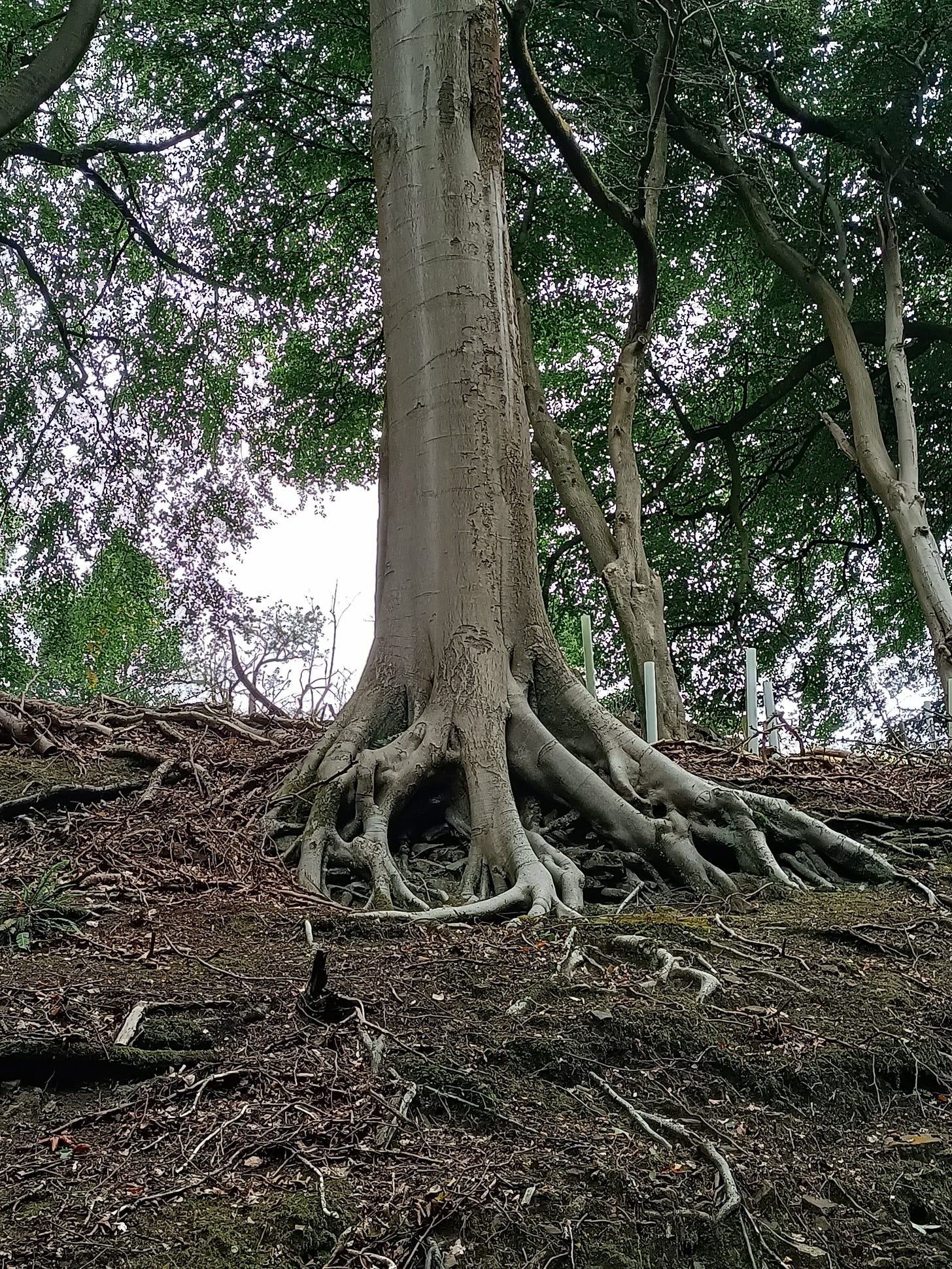
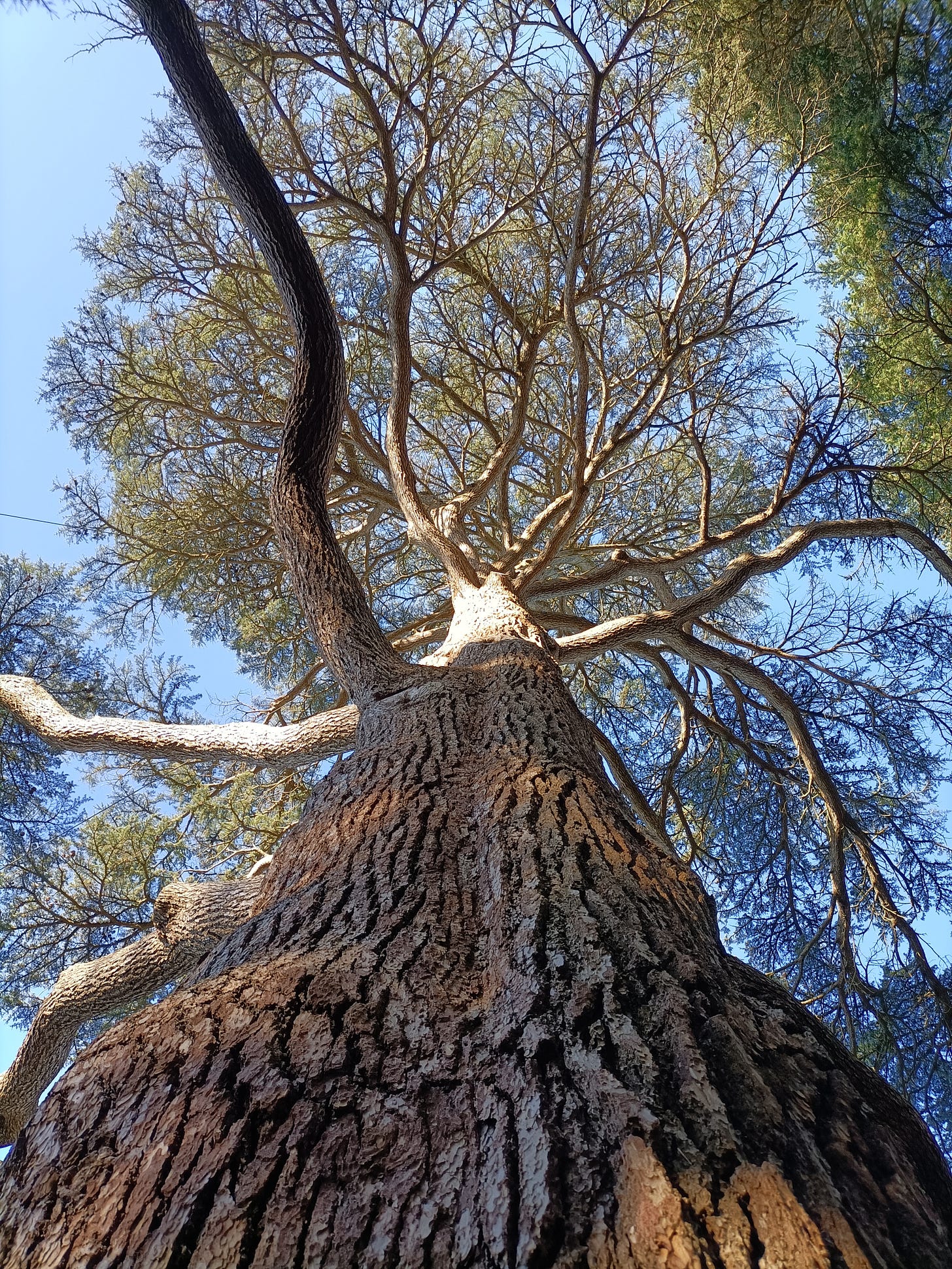

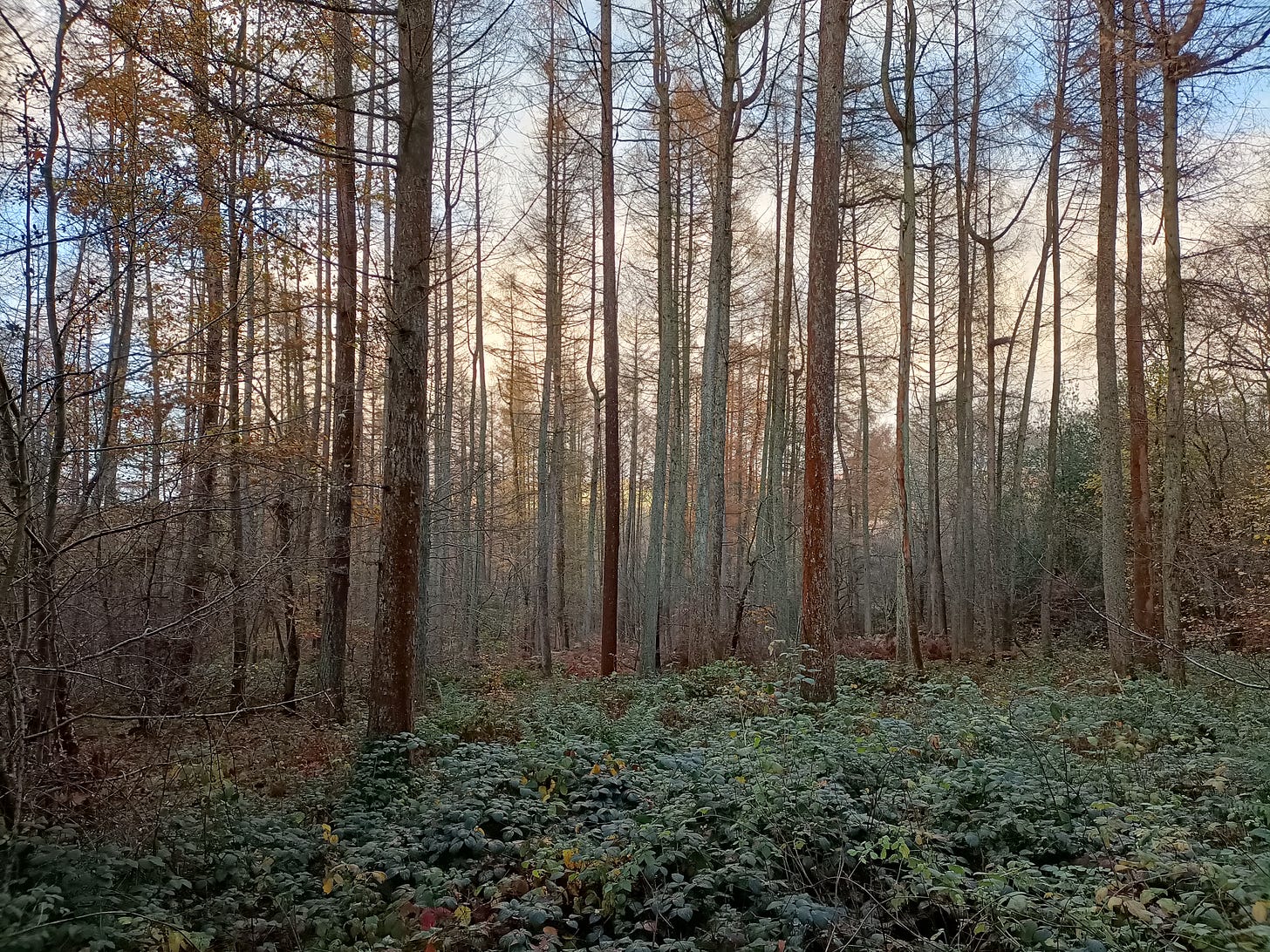

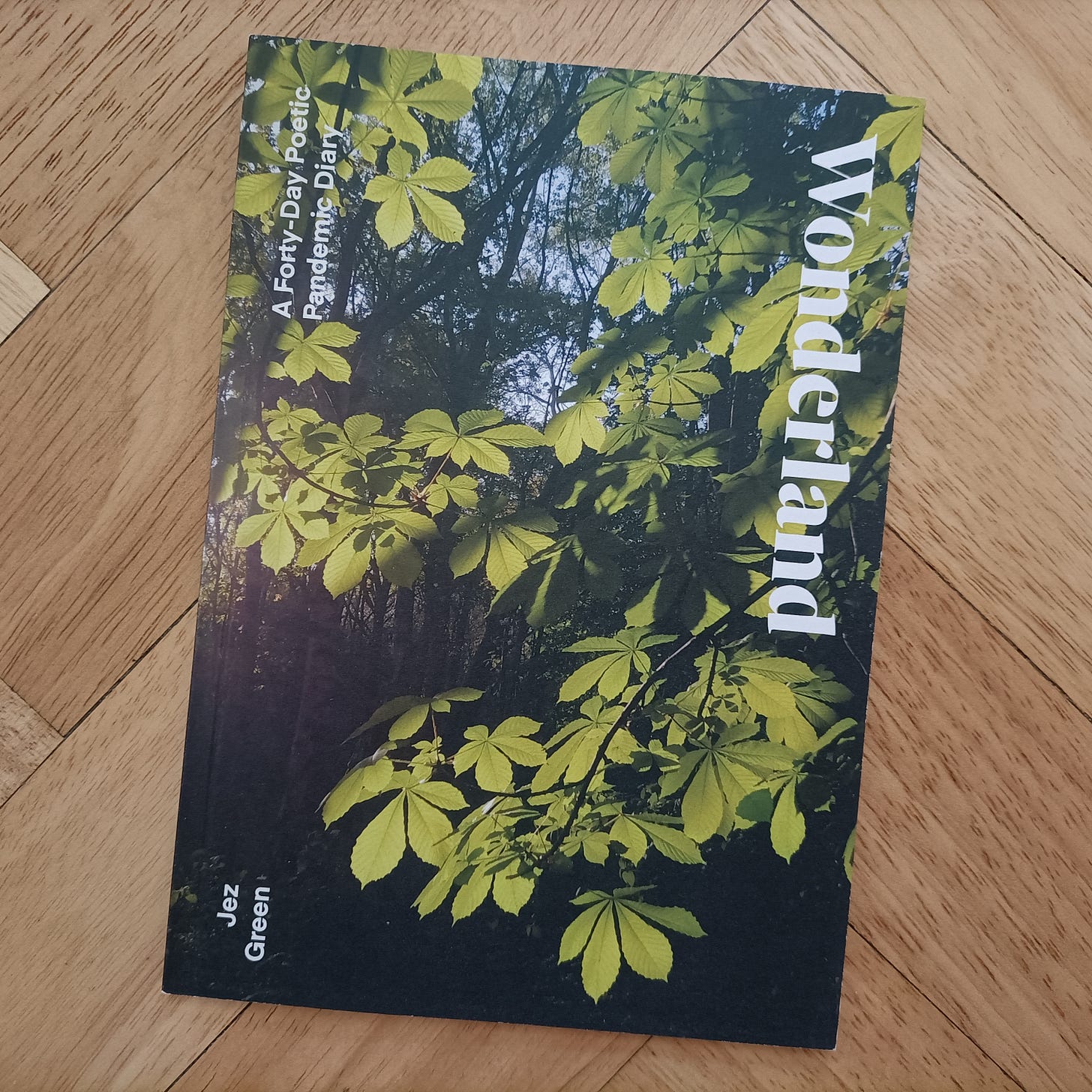
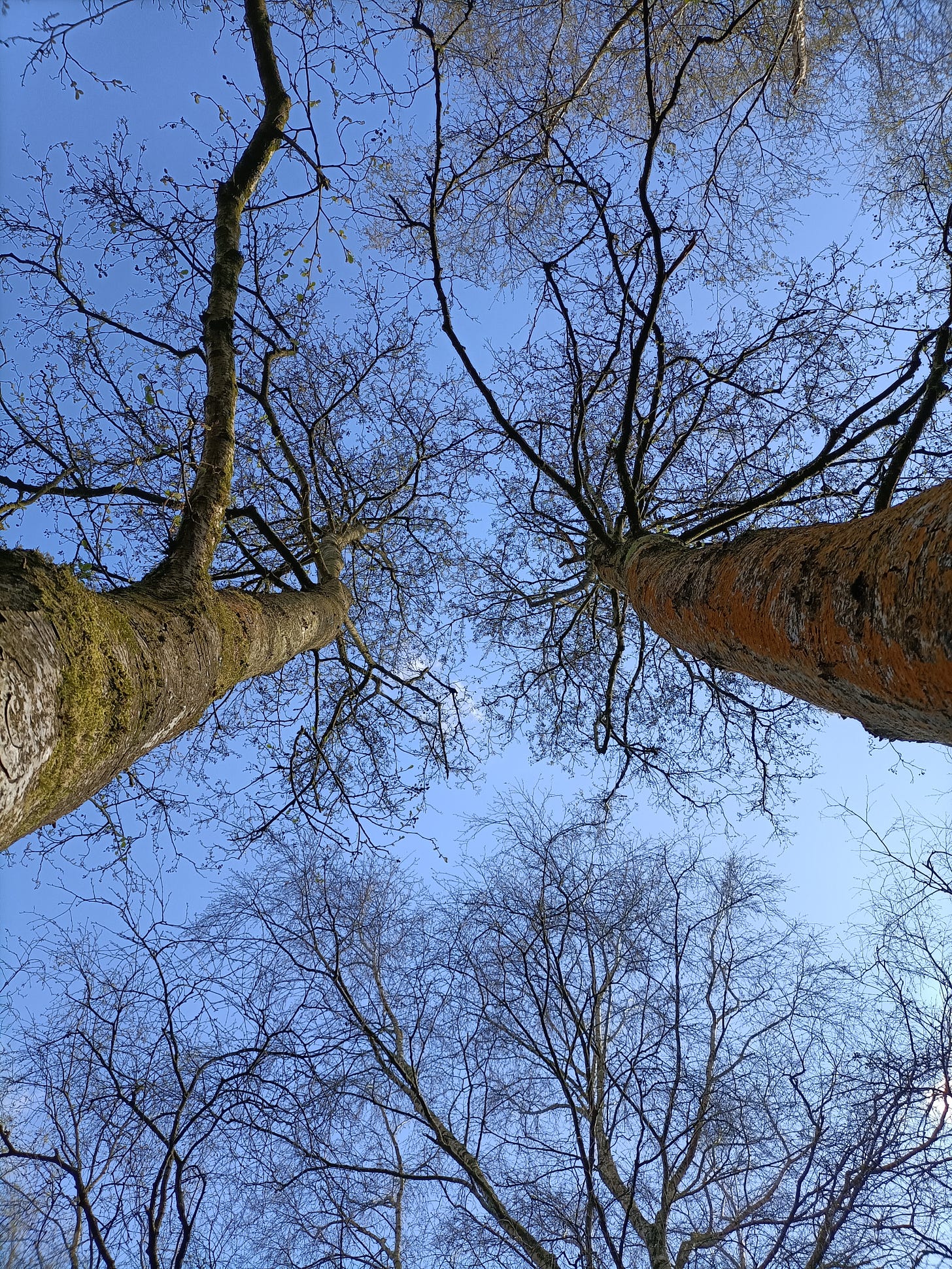

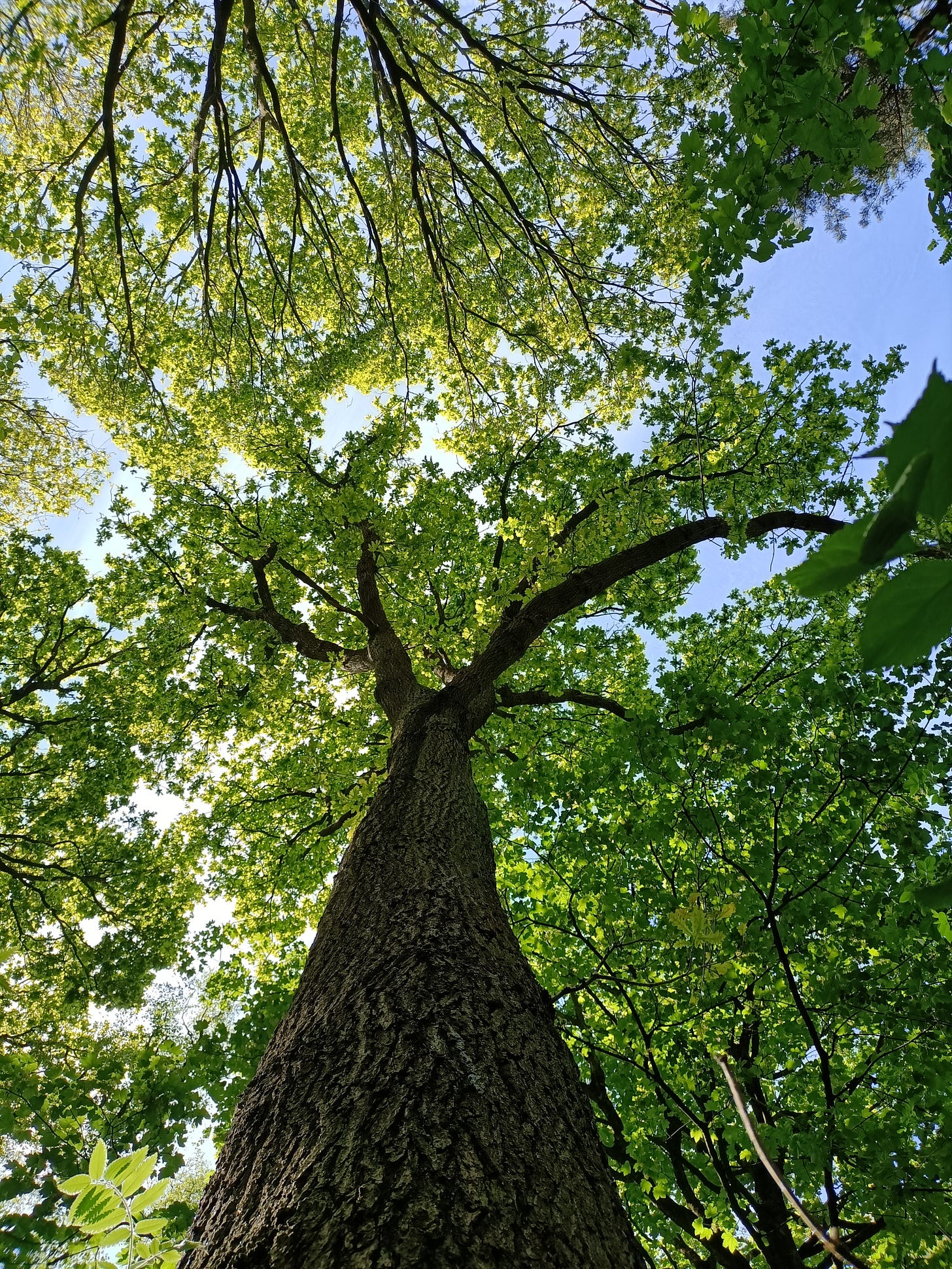
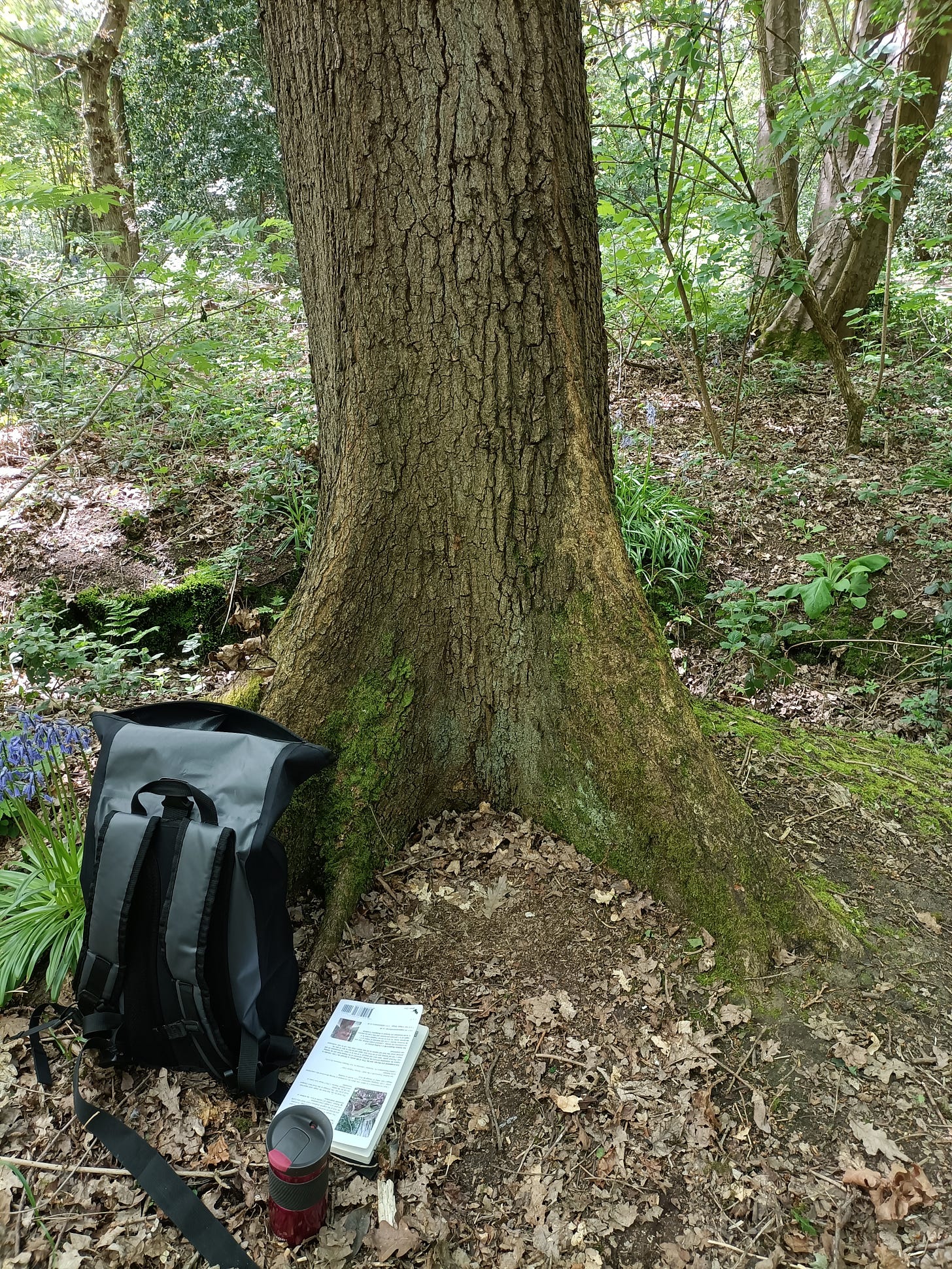

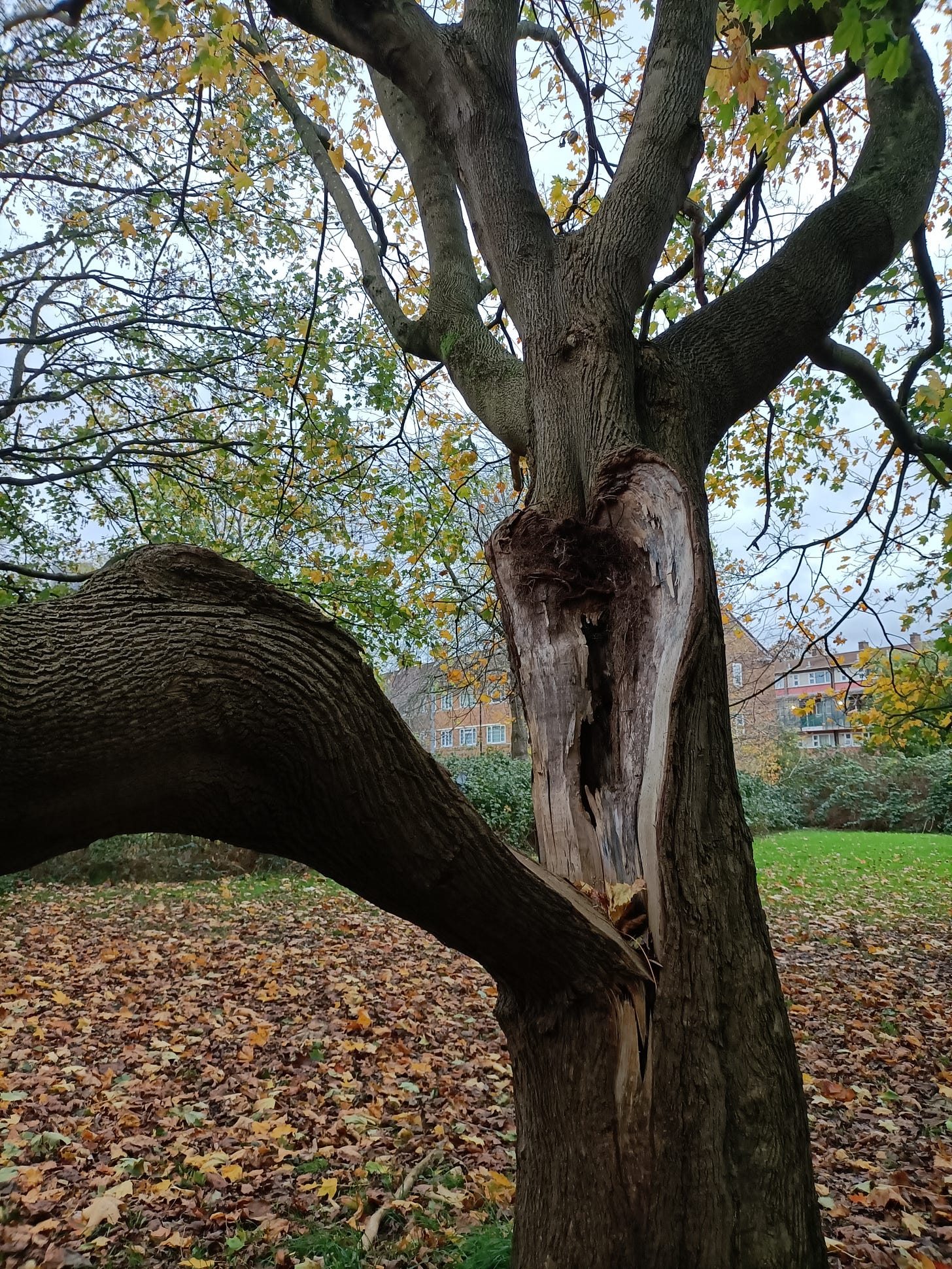

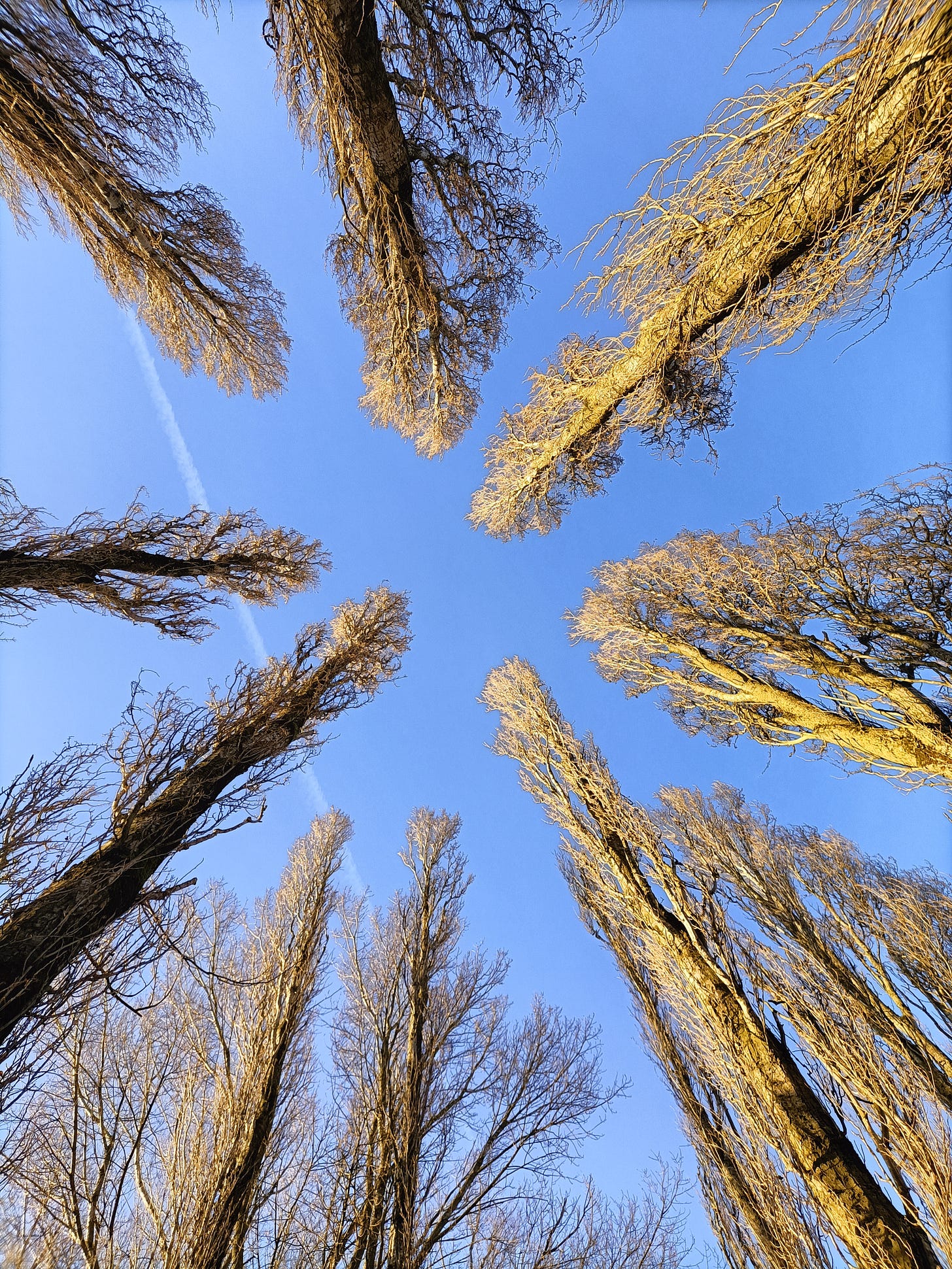








Share this post